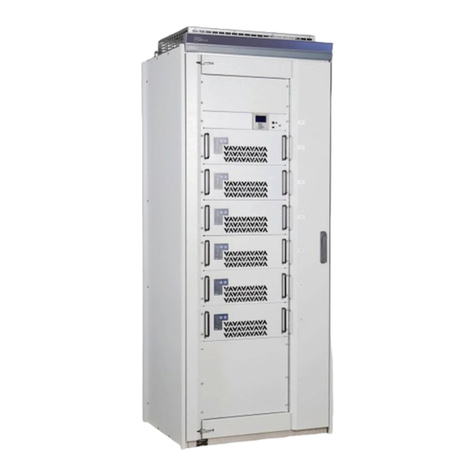
4
KraftPowercon Sweden AB, Hjalmar Petris väg 49, S-352 46 Växjö, Sweden, Tel: +46 470-705200, Fax: +46 470-705201,
www.kraftpowercon.com
5.7.3Show rectifier......................................................................................................................... 20
5.7.3.1Show voltage and current.................................................................................................. 20
5.7.3.2Show detailed rectifier data ............................................................................................... 20
5.7.4Show insulation ..................................................................................................................... 21
5.7.5Show statistics........................................................................................................................ 21
5.7.5.1Menu option...................................................................................................................... 21
5.7.5.2Mains fault ........................................................................................................................ 21
5.7.5.3External fault ..................................................................................................................... 21
5.7.5.4Operating time .................................................................................................................. 21
5.7.5.5Program version ................................................................................................................ 21
5.8CHARGE CONTROL.................................................................................................................. 22
5.8.1General.................................................................................................................................. 22
5.8.2Start/stop equalizing charging ................................................................................................ 22
5.8.3Manual battery circuit test ..................................................................................................... 22
5.9ALARM ...................................................................................................................................... 22
5.9.1General.................................................................................................................................. 22
5.9.2Alarm settings ........................................................................................................................ 22
5.9.2.1Level ................................................................................................................................. 23
5.9.2.2Delay ................................................................................................................................ 23
5.9.2.3Relay (A-D)........................................................................................................................ 23
5.9.2.4Relay (E-H) ........................................................................................................................ 23
5.9.2.5Return ............................................................................................................................... 23
5.9.2.6Show ................................................................................................................................. 24
5.9.3Alarm log............................................................................................................................... 24
5.9.4Rectifier status log.................................................................................................................. 24
5.10SETTINGS .................................................................................................................................. 24
5.10.1General.................................................................................................................................. 24
5.10.2Adjust the voltage level for float charging .............................................................................. 24
5.10.3Adjust the voltage level for equalizing charging..................................................................... 24
5.10.4Adjust the current limit value................................................................................................. 25
5.10.5Adjust clock........................................................................................................................... 25
5.11ADVANCED .............................................................................................................................. 25
5.12TEST & CALIBRATE.................................................................................................................... 25
5.12.1General.................................................................................................................................. 25
5.12.2Show status for digital inputs ................................................................................................. 25
5.12.3Test digital outputs................................................................................................................. 26
5.12.3.1Test alarm outputs A-D ................................................................................................. 26
5.12.3.2Test alarm outputs E-H .................................................................................................. 26
5.12.3.3Test other outputs.......................................................................................................... 26
5.12.4Calibrate measuring of battery voltage................................................................................... 26
5.12.5Calibrate measurement of mid voltage................................................................................... 27
5.12.6Lamp test ............................................................................................................................... 27
5.13FUNCTIONS.............................................................................................................................. 27
5.13.1General.................................................................................................................................. 27
5.13.2Select language...................................................................................................................... 27
5.13.3Parameters for mid voltage measurement .............................................................................. 27
5.13.4Parameters for measuring battery temperature ....................................................................... 28
5.13.5Parameters for battery circuit test ........................................................................................... 29
5.13.6Parameters for equalizing charging........................................................................................ 29
5.13.7Lowest possible voltage level, Uminimum............................................................................. 30
5.13.8Highest possible voltage level, Umaximum (HVSD) .............................................................. 30
5.13.9Parameters for RI compensation............................................................................................. 30
5.13.10Parameters for external alarm ............................................................................................ 30
5.13.11Special functions ............................................................................................................... 31
5.13.12Other functions ................................................................................................................. 31
5.14SYSTEM DATA........................................................................................................................... 31
5.14.1General.................................................................................................................................. 31
5.14.2Specify rated voltage.............................................................................................................. 31




























